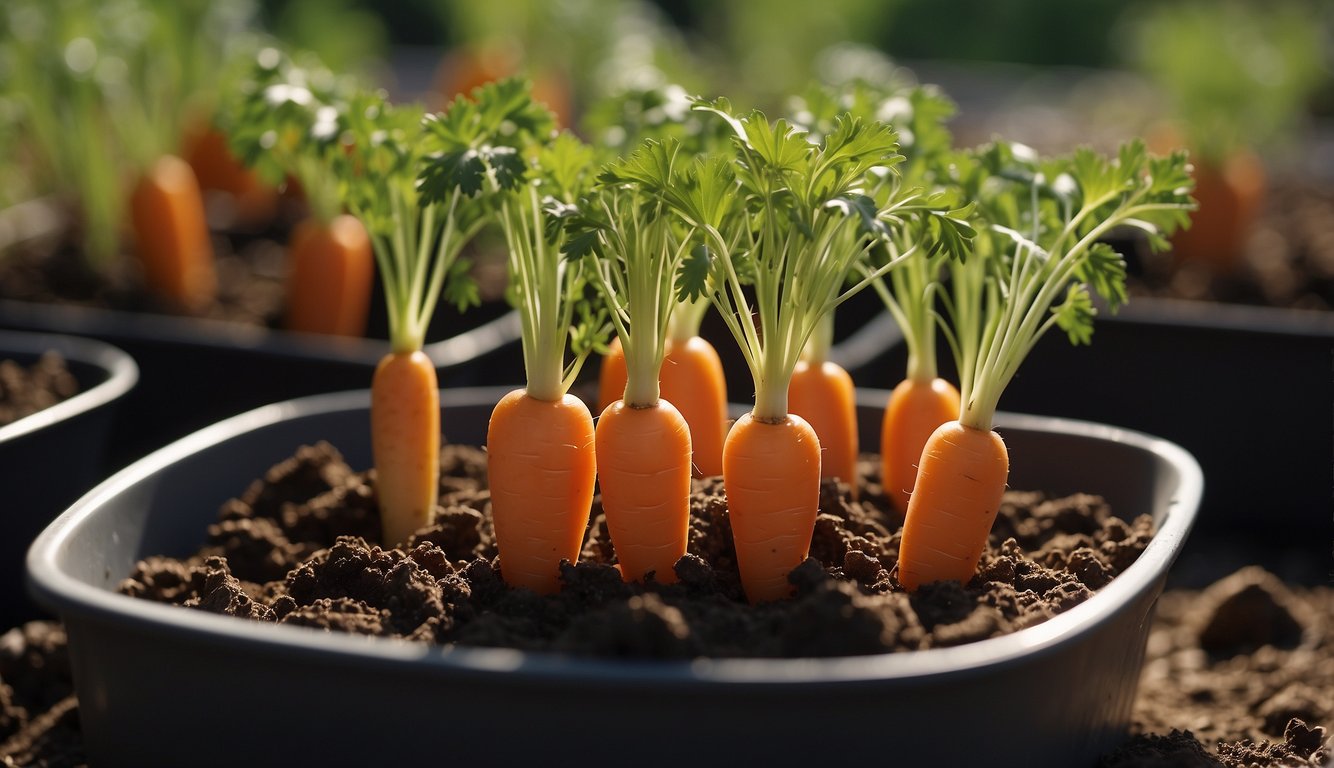TheHerbProf.com is a treasure trove of knowledge for those interested in natural healing and herbal remedies. The website is run by Paul Johnston MD. A naturopathic who has not only received extensive education in the field but also has personal experience in self-healing.
To Grow carrots in containers is a convenient way to produce your own fresh root vegetables, even if you don’t have the acreage for a full-fledged vegetable garden. With the right tools and techniques, you can get a bountiful harvest of sweet, crunchy carrots year-round. As someone who has grown carrots in containers for years, I can attest to the ease and satisfaction of this method.
Carrots are a great vegetable to grow in containers because they don’t require a lot of space, and they’re not picky about soil quality. In fact, they prefer loose, well-draining soil that’s free of rocks and other debris. Container gardening is also a great way to control the environment in which your carrots grow, ensuring that they get the right amount of water, light, and nutrients they need to thrive. Whether you’re a seasoned gardener or a beginner, growing carrots in containers is a fun and rewarding way to get fresh produce right at home.
Choosing the Right Container
When it comes to growing carrots in containers, choosing the right container is crucial. Here are some important factors to consider:
Container Types
There are different types of containers to choose from, including plastic containers and fabric pots. Plastic containers are durable and come in various sizes, but they can get hot in direct sunlight. Fabric pots are breathable and can prevent overwatering, but they may not last as long as plastic containers.
Importance of Drainage Holes
Whatever container you choose, make sure it has drainage holes. Good drainage is essential to prevent waterlogged soil, which can lead to root rot. If your container doesn’t have drainage holes, drill some in the bottom.
Depth and Size Considerations
Carrots need a deep container to accommodate their long taproots. A container that is at least 12 inches deep is ideal. The container should also be wide enough to accommodate several carrot plants.
When choosing a container, consider the space you have available and how many carrots you want to grow. Keep in mind that larger containers will hold more soil, which can be heavy and difficult to move.
Overall, choosing the right container for growing carrots in containers is crucial to your success. By considering the factors above, you can select a container that will provide your carrots with the right environment to thrive.
Selecting Soil and Fertilizer To Grow Carrots in Containers
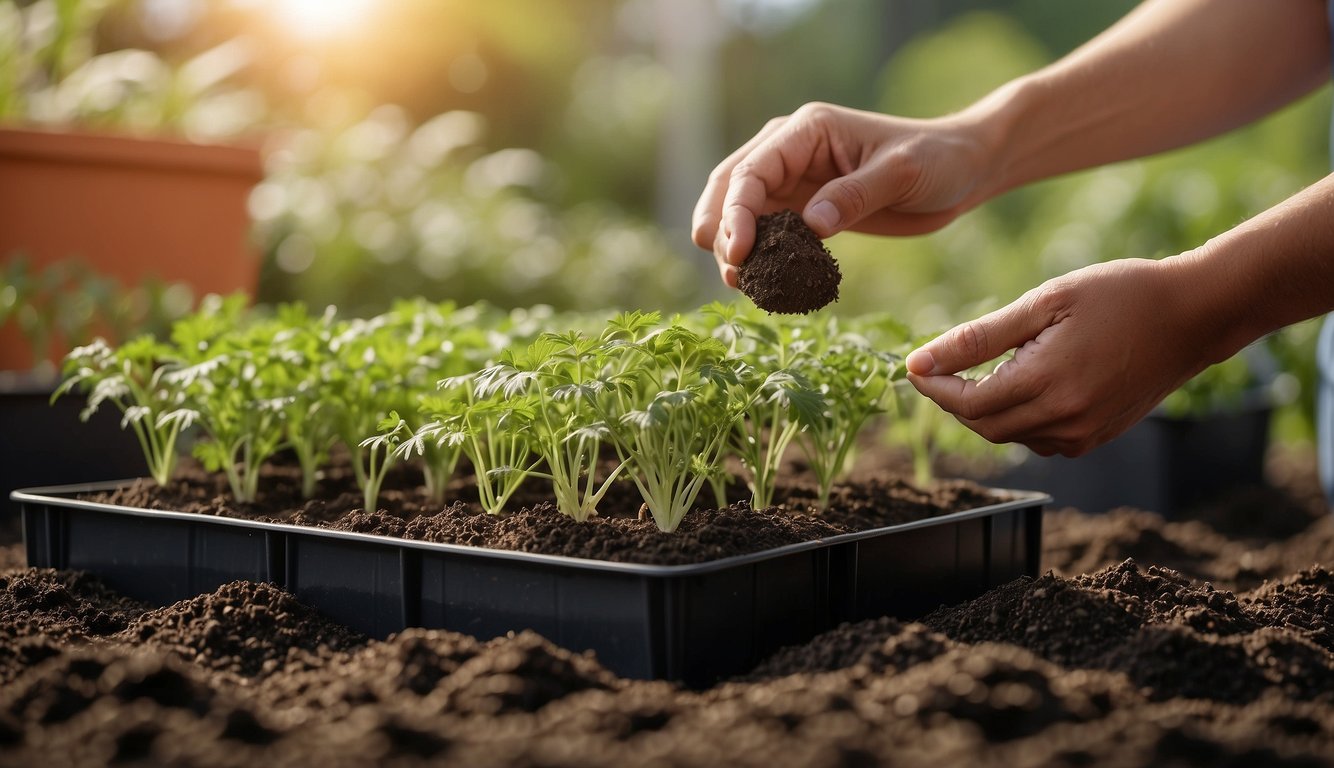
When it comes to growing carrots in containers, selecting the right soil and fertilizer is crucial for ensuring a healthy and productive harvest. In this section, I will discuss the soil mix and fertilizer types that work best for container-grown carrots.
Soil Mix for Carrots
Carrots need well-draining soil that is loose and friable to allow their roots to develop properly. A good soil mix for growing carrots in containers should be light, fluffy, and well-aerated. A mix of potting soil, compost, and perlite or vermiculite is an excellent choice. The potting soil provides a good base, while the compost adds nutrients and improves drainage, and the perlite or vermiculite helps to keep the soil loose and aerated.
Nutrient Requirements
Carrots have specific nutrient requirements that must be met for optimal growth. They require a balanced fertilizer that contains nitrogen, phosphorus, and potassium in a ratio of 1:2:2. In addition, they also need micronutrients such as calcium, magnesium, and boron. These nutrients can be provided through the soil mix and/or through fertilization.
Fertilizer Types
There are several types of fertilizers that can be used to feed container-grown carrots. Compost tea is an excellent organic fertilizer that provides a balanced mix of nutrients. It can be made by steeping compost in water for several days and then using the resulting liquid to water the plants. Another option is to use a slow-release granular fertilizer that is specifically formulated for vegetables. These fertilizers release nutrients slowly over time, providing a steady supply of nutrients to the plants. Finally, liquid fertilizers can also be used to feed container-grown carrots. These fertilizers are mixed with water and applied directly to the soil.
Selecting the right soil mix and fertilizer is essential for growing healthy and productive carrots in containers. A well-draining soil mix that is light and fluffy, along with a balanced fertilizer that contains the necessary nutrients, will ensure that your container-grown carrots thrive.
Planting Carrot Seeds To Grow Carrots in Containers
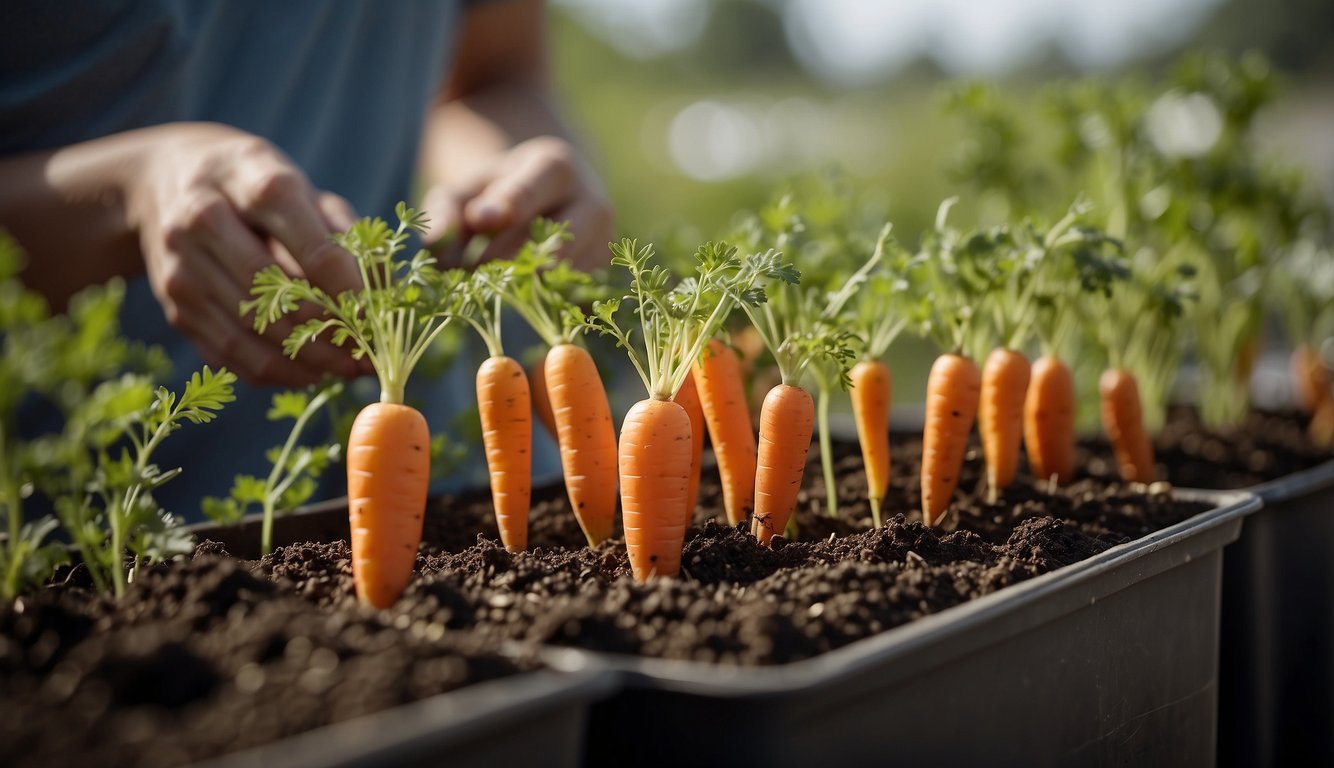
Carrots are a great vegetable to grow in containers. They are easy to grow and can be grown year-round. In this section, I will discuss the best practices for planting carrot seeds in containers.
When to Sow Seeds
The best time to sow carrot seeds is in the early spring or fall. Carrots prefer cooler temperatures, so avoid planting them during the hot summer months. In warmer climates, it is best to plant carrots in the fall or winter.
Seed Spacing and Thinning
When planting carrot seeds, it is important to space them correctly. Carrot seeds are small, so it can be difficult to space them properly. I recommend making shallow trenches in the soil and spacing the seeds about 2 inches apart. Once the seeds have sprouted, thin them to about 1-2 inches apart. Thin seedlings of growing carrots to 1 to 4 inches (2.5-10 cm.) apart when they are 2 inches (5 cm.) in height. This will ensure that the carrots have enough room to grow and develop properly.
Germination Tips
Carrot seeds can take up to three weeks to germinate. To speed up the germination process, keep the soil moist and at a consistent temperature of around 60-70°F (15-21°C). Once the seeds have sprouted, make sure to keep the soil moist but not waterlogged. Overwatering can cause the carrots to rot.
Planting carrot seeds in containers is an easy and rewarding experience. By following these tips on when to sow seeds, seed spacing, thinning, and germination, you can grow delicious and healthy carrots in your own home.
Caring for Carrots in Containers
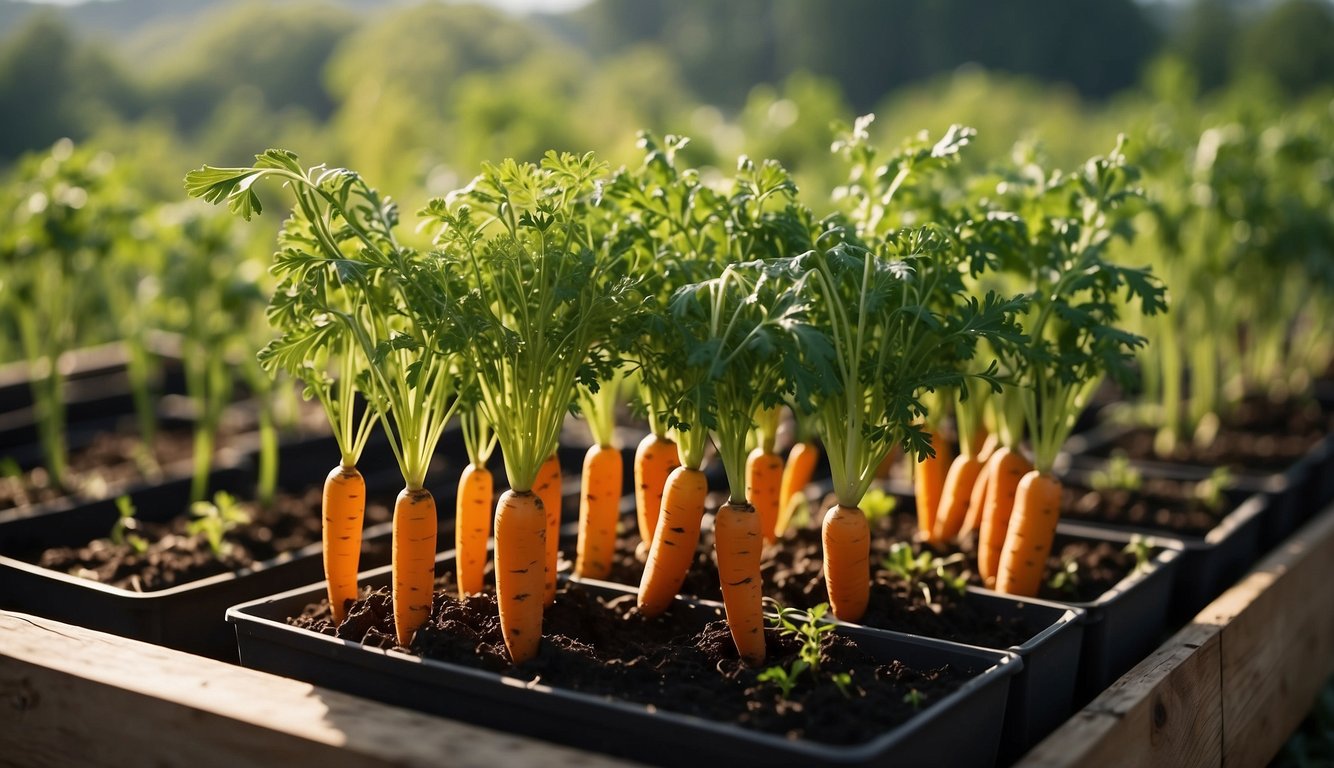
Growing carrots in containers is a great way to enjoy fresh produce even if you don’t have much space. However, it’s important to take good care of your carrots to ensure they grow strong and healthy. In this section, I’ll share some tips on how to properly care for your container-grown carrots.
Watering Techniques To Grow Carrots in Containers
Proper watering is crucial for growing carrots in containers. Since containers tend to dry out more quickly than garden beds, you’ll need to water your carrots more frequently. However, you don’t want to overwater them either, as this can lead to rot and other problems.
To water your carrots, you can use a watering can or a hose with a gentle spray nozzle. Be sure to water the soil thoroughly, but avoid getting the leaves wet. Carrots don’t like to sit in soggy soil, so make sure the container has good drainage.
Monitoring Soil Moisture
To ensure your carrots are getting the right amount of water, you’ll need to monitor the soil moisture regularly. Stick your finger about an inch into the soil to check for moisture. If it feels dry, it’s time to water. If it feels moist, you can wait a day or two before watering again.
Another way to monitor soil moisture is to use a moisture meter. These handy tools can give you an accurate reading of the soil moisture level, so you can water your carrots at the right time.
Sunlight and Temperature
Carrots need full sun to grow properly, so make sure your container is in a sunny location. If you don’t have a spot that gets full sun all day, try to find a spot that gets at least six hours of sunlight.
In addition to sunlight, temperature is also important for growing carrots. Carrots prefer cooler temperatures, so try to keep your container in a spot that stays between 60 and 70 degrees Fahrenheit. If the temperature gets too hot, your carrots may not grow properly.
By following these tips for watering, monitoring soil moisture, and providing the right amount of sunlight and temperature, you can help your container-grown carrots thrive. With a little care and attention, you’ll be enjoying fresh, homegrown carrots in no time!
Managing Pests and Diseases To Grow Carrots in Containers

As with any garden, pests and diseases can be a problem when growing carrots in containers. However, with proper care and attention, you can prevent and manage these issues.
Common Pests
One of the most common pests that can affect carrots is aphids. These tiny insects can quickly infest your plants, causing damage to both the leaves and the roots. To prevent an aphid infestation, it is important to keep your container clean and free of debris. Regularly inspect your plants for any signs of aphids, such as curled leaves or sticky residue. If you do notice an infestation, you can use neem oil or insecticidal soap to control the problem.
Another pest to watch out for is the carrot rust fly. These flies lay their eggs in the soil around your carrots, which can cause damage to the roots. To prevent an infestation, cover your container with a floating row cover or mesh netting. This will prevent the flies from laying their eggs in the soil.
Disease Prevention
Carrots can also be susceptible to various diseases, such as root rot and leaf blight. To prevent these diseases, it is important to keep your container clean and well-drained. Make sure your container has proper drainage holes and avoid overwatering your plants. Additionally, avoid planting your carrots in the same container year after year, as this can increase the risk of disease.
Natural Pest Control
If you prefer to use natural methods to control pests, there are several options available. For example, you can plant companion plants, such as marigolds or chives, which can repel pests. You can also use natural predators, such as ladybugs or lacewings, to control aphids. Additionally, you can make your own insecticidal soap using common household ingredients, such as dish soap and water.
By following these tips, you can prevent and manage pests and diseases when growing carrots in containers. With proper care and attention, you can enjoy a bountiful harvest of delicious, homegrown carrots.
Harvesting and Storage
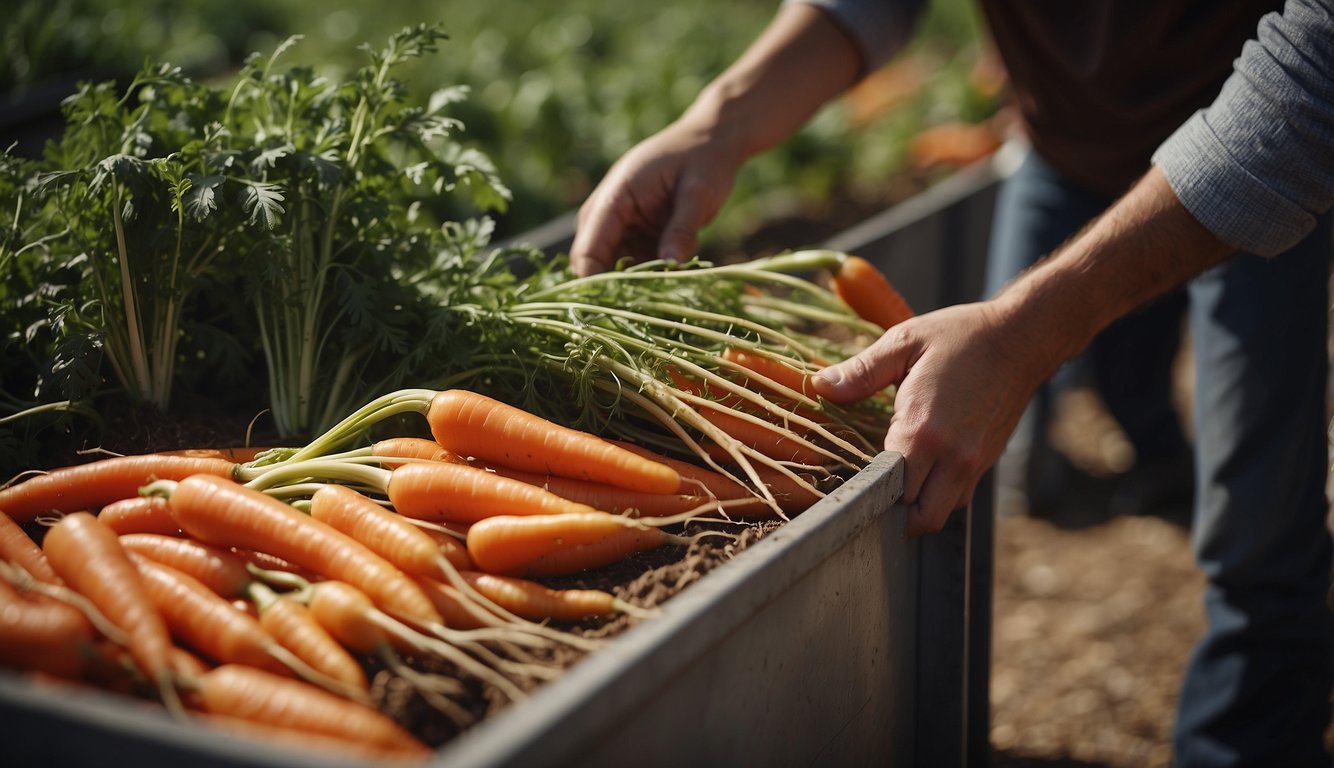
Harvesting and storing your carrots is an exciting and rewarding step. Here are some tips to ensure your carrots are picked at the right time and stored properly:
When to Harvest Carrots
Carrots are usually ready to harvest 60-80 days after planting, depending on the variety and growing conditions. You can check if the carrots are ready by gently pulling out one from the soil. If the carrot is the desired size and shape, you can harvest the rest of the carrots.
How to Pick Carrots
When harvesting carrots, it is important to handle them carefully to avoid damaging them. Use a garden fork or trowel to loosen the soil around the carrot, then gently pull the carrot out of the soil by the leaves. Avoid pulling the carrot by the stem, as this can cause damage.
Storing Container-Grown Carrots
After harvesting your carrots, it is important to store them properly to maintain their freshness and flavor. Remove the tops of the carrots, leaving about an inch of stem, and wash the carrots thoroughly. Allow them to dry completely before storing them in a cool, dark place.
You can store your carrots in a plastic bag with a few holes punched in it to allow for air circulation, or in a container filled with damp sand or sawdust. Carrots can be stored for several months if stored properly.
By following these simple tips, you can harvest and store your container-grown carrots with confidence, knowing that they will be fresh and delicious when you’re ready to enjoy them.
Advanced Tips To Grow Carrots in Containers

As an experienced gardener, I have learned a few advanced tips for growing carrots in containers that I’d like to share with you. These tips will help you to get the most out of your container garden and grow healthy, delicious carrots.
Choosing Carrot Varieties
When growing carrots in containers, it is important to choose the right variety. Short-rooted varieties, such as Parisian Market, Red Cored Chantenay, and Nantes, are excellent choices for container gardening. These varieties thrive when they have deep, loamy soil to stretch their roots, ideally 12 inches of soil space. If you are using deep containers, then your choice of variety is hardly limited. Amsterdam, Danvers, and Oxheart are also great options for container gardening.
Companion Planting
Companion planting is an excellent way to maximize your container garden space and improve the health of your carrot plants. Some good companion plants for carrots include onions, garlic, and leeks. These plants help to repel pests and improve the soil quality. Additionally, planting herbs like parsley, dill, and cilantro near your carrot plants can help to attract beneficial insects that will help to keep pests at bay.
Extending the Growing Season
If you live in an area with a short growing season, you can still grow carrots in containers by using row covers. Row covers help to protect your plants from the cold weather and extend the growing season. You can also use a cold frame or a hoop house to protect your plants from the weather.
By following these advanced tips for container-grown carrots, you can grow healthy, delicious carrots in your own backyard. With the right variety, companion plants, and growing techniques, you can enjoy a bountiful fall harvest of fresh, home-grown carrots.
Grow Carrots in Containers: A Gardening Adventure with TheHerbProf.com
Today, we’re digging into the world of Growing Carrots in Containers. This method can turn your patio or balcony into a mini vegetable garden!
First up, The Container. Carrots need deep containers to grow long and straight. And guess what? TheHerbProf.com has a detailed guide on choosing the right containers for your plants. It’s like having a personal garden planner!
Next, the Planting stage. Carrots are direct sown, meaning you plant the seeds right where they’ll grow. And TheHerbProf.com? It’s got all the info you need to sow your seeds correctly. It’s a gardener’s dream!
Then there’s the Care stage. Your carrots will need regular watering and plenty of sunlight. And with TheHerbProf.com, you’ve got a guide to caring for your container garden. It’s like a DIY project for your patio!
In short, Growing Carrots in Containers and TheHerbProf.com are a match made in garden heaven. They offer a blend of practical gardening advice and fascinating plant facts. So, whether you’re a carrot enthusiast or a green newbie, there’s always something new to learn!
Remember, folks, you don’t need a big garden to grow your own food. Keep exploring TheHerbProf.com for more container gardening adventures!
References – Grow Carrots in Containers
Little Herb Encyclopedia, by Jack Ritchason; N.D., Woodland Publishing Incorporated, 1995
The Ultimate Healing System, Course Manual, Copyright 1985, Don Lepore
Planetary Herbology, Michael Tierra, C.A., N.D., Lotus Press, 1988
Handbook of Medicinal Herbs, by James A. Duke, Pub. CRP Second Edition 2007
The Complete Medicinal Herbal, by Penelope Ody, Published by Dorling Kindersley
Check the Following Articles!
Spanish Garlic: A Flavorful Addition to Your Kitchen
Garlic Garden: How to Grow and Harvest Successfully
Roasting Garlic in Oven: A Simple Guide to Delicious Dishes
Food You Can Grow from Scraps: More Money Less Waste!
Frequently Asked Questions – Grow Carrots in Containers
What type of soil should I use for growing carrots in containers?
For growing carrots in containers, it is recommended to use a well-draining, loose, and fertile soil mix with a pH range of 6 to 7. A soilless potting mix that is free of weed seeds, diseases, and pests is ideal. Avoid using heavy and compacted soils, as they may hinder carrot growth and development.
Can you grow carrots indoors using containers, and if so, how?
Yes, you can grow carrots indoors using containers. Choose a container that is at least 12 inches deep with proper drainage holes. Fill the container with a well-draining soil mix, plant the carrot seeds about 1 cm deep, and water gently. Place the container in a location that receives at least 6 hours of sunlight daily. Monitor the soil moisture and water regularly to maintain even soil moisture.
What are some recommended companion plants for carrots in container gardens?
Companion planting with carrots can help to deter pests and improve soil health. Some recommended companion plants for carrots in container gardens include onions, garlic, leeks, chives, and radishes. These plants can help to repel carrot flies and other pests while also improving soil structure and nutrient availability.
How deep should a container be to successfully grow carrots?
The depth of the container is important for successful carrot growth. Carrots need a deep container that allows for proper root development. A container that is at least 12 inches deep is recommended for growing carrots in containers. This depth allows the carrot roots to grow long and straight, resulting in healthy and flavorful carrots.
What are the steps to grow carrots from carrot tops in a container?
Growing carrots from carrot tops is a fun and easy project for kids and adults alike. To grow carrots from carrot tops in a container, cut off the top of a carrot, leaving about an inch of the stem. Place the carrot top in a shallow container filled with water, making sure the water covers the bottom of the carrot top. Change the water every few days and wait for the carrot top to sprout roots. Once the roots are about an inch long, plant the carrot top in a container filled with soil mix and water gently.
How much sunlight is required for container-grown carrots to thrive?
Carrots require at least 6 to 8 hours of sunlight daily to thrive in containers. Place the container in a location that receives full sun, preferably facing south. If you are growing carrots indoors, place the container near a sunny window or use grow lights to provide the necessary light.
